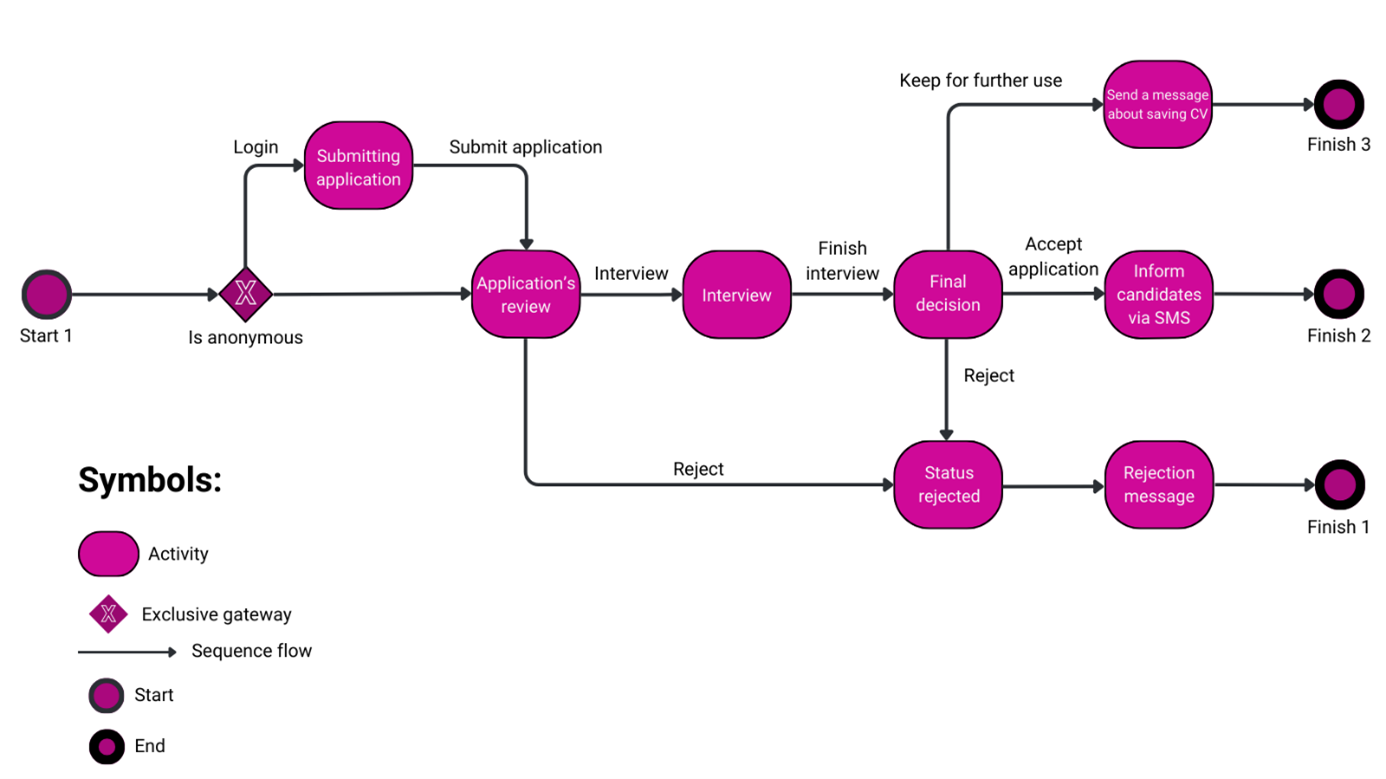Table of Contents
ToggleWhat is Business Process Modeling Notation (BPMN)?
BPMN is a universally accepted graphical notation used to represent aspects of business processes succinctly. It offers a universally understood language that enables diverse stakeholders to decipher, scrutinize, and efficiently communicate complex processes seamlessly.The BPMN diagrams encompass an array of defined symbols, interconnected elements and rigorous notation rules that make process modelling profoundly intuitive and readily accessible
What is BPMN 2.0?
BPMN 2.0 represents an enriched iteration of the BPMN standard, which has introduced an array of supplementary features and overarching enhancements. This updated version introduces novel elements, augments BPMN notation options, and elevates the support for representing intricate business processes. Over time, BPMN 2.0 has established itself as the undisputed standard for process modeling and is ubiquitously adopted across diverse industries.
BPMN – purpose and benefits
What is BPMN meaning in business? It serves a myriad of practical purposes in the domain of process management:
- Process documentation: It offers a visually intuitive and standardized approach for the detailed documentation of multifaceted business processes, facilitating seamless understanding and collaborative engagement within cross-functional teams.
- Process Analysis: BPMN provides the capacity to perform analyses of existing processes, empowering organizations to identify bottlenecks and inherent optimization opportunities.
- Process Optimization: By modeling processes using BPMN, organizations gain invaluable insights into enhancing the efficiency and efficacy of their operational workflows, thereby fostering streamlined operations.
Benefits of BPMN
- Standardized documentation: BPMN effectively establishes a universally recognized standard for process documentation, greatly simplifying the circulation and comprehension of processes across distinct departments and diverse teams.
- Augmented process visibility: BPMN diagrams provide lucid, highly accessible representations of various processes, thereby enhancing visibility and comprehensibility for diverse stakeholders.
- Amplified collaborative potential: Teams can effortlessly discuss and assimilate complex processes through BPMN, facilitating enhanced collaboration and decision-making.
Streamlined process design: BPMN adeptly supports the design of efficient and effective business processes, thereby contributing to a reduction in operational inefficiencies and bolstering overall productivity.
BPMN – diagram icons, elements and symbols
BPMN diagrams contain a spectrum of meticulously defined symbols, elements, and icons. A nuanced understanding of these symbols is imperative for creating and deciphering BPMN diagrams effectively. Below, you will find a selection of fundamental BPMN symbols:
- Flow objects: These symbols represent various activities, tasks, events, and gateways encountered within a business process.
- Connecting objects: This category encompasses sequence flows, message flows, and associations, which facilitate the interconnectedness and synchronization of elements.
- Swimlanes: Organizational entities are encapsulated within swimlanes and each represents a distinct role or department involved in the process.
- Artifacts: These include data objects and groups, which add contextual information to the BPMN diagrams.
Here is an example of a BPMN diagram demonstrating the hiring process:

To craft precise BPMN diagrams, it is indispensable to possess a thorough grasp of the connotations and applications of these symbols.
BPMN: tutorials & training
For those who seek to embark on a journey of mastering BPMN and enhancing their skills in creating efficacious diagrams, a wealth of BPMN tutorials and training resources are readily available. We highly recommend you build your diagram with a demo version of our browser-based BPMN tool NAVIGATOR365 and get to know what the BPMN process looks like in practice. Plenty of educational materials (NAVIGATOR365 Academia) will help you encompass the fundamentals of this tool, advanced modeling techniques and practical applications. You can treat it as an accelerated learning course and an individual BPMN training.
Business process modeling – key tips
Effective business process modeling hinges on precise attention to detail and unwavering adherence to best practices. The following key tips are crucial for the proficient execution of business process modeling efforts:
- Holistic business understanding: Initiate your modeling by acquiring an in-depth comprehension of the business processes that are slated for representation.
- Stakeholder engagement: Involving relevant stakeholders is vital, ensuring that the BPMN model aligns smoothly with the complexity of the business process.
- BPMN software utilization: Using BPMN software is essential to create precise and professional BPMN diagrams. One of the most notable BPMN examples is NAVIGATOR365, a comprehensive browser-based solution.
- Consistency and clarity: Uphold a consistent and lucid approach in crafting BPMN diagrams to guarantee their accessibility and ease of comprehension.
How to do Business Process Modeling with NAVIGATOR365 software tool?
For those in search of a robust and feature-rich BPMN tool, NAVIGATOR365 offers a potent solution for business process modeling and automation. NAVIGATOR365 streamlines the process of creating, analyzing, and optimizing BPMN diagrams, granting organizations the capability to focus on enhancing their operational efficiency. To explore NAVIGATOR365 and its capabilities in-depth, visit NAVIGATOR365 Workflow Automation.
What is the difference between BPMN and flowchart?
While both BPMN and flowcharts serve as invaluable tools for visualizing processes, they exhibit distinct disparities. Flowcharts are characterized by their simplicity and are typically used for general process documentation. In contrast, BPMN represents a more detailed, standardized notation precisely adapted for the intricate domain of business process modeling. Discerning these differences is pivotal when selecting the appropriate tool to match the specific needs of your organization.
In summation, BPMN stands as an invaluable standard for business process modeling, offering a comprehensive array of symbols and notation rules designed to deliver crystal-clear and efficacious process representations. With the augmentation of BPMN 2.0, this notation has transcended its predecessors, establishing itself as a fundamental tool for organizations seeking to enhance and streamline their operational processes. Whether you are a novice embarking on your BPMN journey or a seasoned process modeler, the profundity of BPMN understanding is an essential asset for efficacious business process management.
Sounds interesting? Get to know more about No-code solutions, automation and superapps in NAVIGATOR365!
